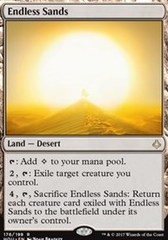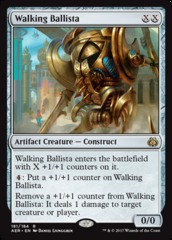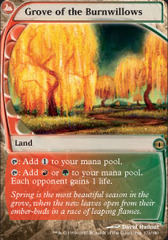Amulet Breach

My Modern PPTQ season was cut short on the first weekend when I won in Witney with this:
| Main Deck |
| 4 Amulet of Vigor |
| 3 Sakura-Tribe Scout |
| 4 Azusa, Lost but Seeking |
| 1 Coalition Relic |
| 4 Through the Breach |
| 4 Primeval Titan |
| 4 Summoner’s Pact |
| 2 Emrakul, the Aeons Torn |
| 1 Worldspine Wurm |
| 4 Ancient Stirrings |
| 1 Dismember |
| 1 Pact of Negation |
| 4 Simic Growth Chamber |
| 4 Gruul Turf |
| 1 Golgari Rot Farm |
| 1 Boros Garrison |
| 4 Gemstone Mine |
| 2 Crumbling Vestige |
| 1 Forest |
| 1 Vesuva |
| 1 Teetering Peaks |
| 1 Endless Sands |
| 1 Ghost Quarter |
| 1 Khalni Garden |
| 1 Radiant Fountain |
| 1 Slayer’s Stronghold |
| 1 Sunhome, Fortress of the Legion |
| 2 Tolaria West |
| SIdeboard |
| 1 Hornet Queen |
| 1 Thragtusk |
| 1 Chameleon Colossus |
| 1 Tireless Tracker |
| 1 Reclamation Sage |
| 2 Pyroclasm |
| 2 Dismember |
| 1 Swan Song |
| 1 Engineered Explosives |
| 1 Chalice of the Void |
| 2 Relic of Progenitus |
| 1 Bojuka Bog |
In honour of Amonkhet’s hour of devastation, Amulet Bloom has risen from the dead! Like most zombies its undead form is slower, shambles around gormlessly, and sometimes looks putrid, but it will overpower you eventually and its best draws are still as terrifying as the best horror movie. So why this deck, and why now? And what on Earth is Endless Sands doing in there?

If your first question is how this bizarre contraption actually works, there are useful resources that explain the deck’s core gimmick and why it was – and maybe is – so powerful. A lot of this advice is specific to the pre-ban list with Bloom, which was very different in important ways, but it’s worth reading regardless:
MTGSalvation primer (pre-ban and post-ban): http://www.mtgsalvation.com/forums/the-game/modern/developing-competitive-modern/556715-amulet-titan
CJ Lack’s Amulet Bloom primer (2014): http://www.castingcommons.com/amulet-vigor-combo-primer/
Matthias Hunt’s Amulet Bloom primer (2014): http://www.starcitygames.com/article/28042_Amulet-Combo-Primer.html
Bobby Fortanely’s Amulet Bloom primer (2016) + sideboard guide: http://www.starcitygames.com/article/32170_Winning-SCGCIN.html
Matthias Hunt’s Pro Tour: Born of the Gods deck tech: https://www.youtube.com/watch?v=jlVUgGlFI4E
Sam Black/Justin Cohen’s Pro Tour: Fate Reforged deck tech: https://www.youtube.com/watch?v=pG98weIT7-I
Kevin Grove’s GP Lille 2016 report (9th) + Amulet Titan primer: https://www.channelfireball.com/articles/lost-but-seeking-bloom-titan-redux/
Bobby Fortanely’s Amulet Titan primer + sideboard guide: https://www.channelfireball.com/articles/amulet-titan-deck-guide/
Amulet Bloom footage: http://www.mtgcoverage.com/decks/Amulet%20Bloom
Amulet Titan footage: http://www.mtgcoverage.com/decks/Amulet%20Titan
I loved the idea of the deck when it surfaced in 2013 but never bothered to build it – why dump that much money on Azusas for a deck that’s only good for FNM? After its breakout performance at Pro Tour: Fate Reforged, I gave it a spin and immediately berated myself for not trying it years ago. My early matches were a comedy of errors but I won a lot and the deck felt incredible. I already loved the deck but, when it won me a Pro Tour invite, I knew I’d only put it down if they made me.
After recovering from the Bloom ban we all saw coming, I tried my best to make the deck work again for the Pro Tour; I quickly concluded it was a lost cause and sleeved up Arcbound Ravager with everyone else. I revisited it a few times since but couldn’t find a list I was happy with. This list isn’t final by any means but feels a lot sturdier than my previous attempts.
Amulet fans are a dedicated bunch. Some of the former Bloom specialists – Fortanely, Piotr Glogowski (kanister on MTGO), Edgar Magalhaes (see egadd2894 on MTGO for plenty of finishes with Amulet: https://www.mtggoldfish.com/player/egadd2894), Jacob Haversat – have continued work on the deck and their current Grove/Relic list (https://www.mtggoldfish.com/deck/690476#paper) is well-tuned for a format defined by Death’s Shadow. Meanwhile, the deck has had several strong GP and Open finishes (and notable coverage moments… https://www.youtube.com/watch?v=IWHERnnKGTE). The deck is showing signs of life and there’s a lot of room for exploration and improvement. I’m not claiming that this version is definitively better, just highlighting the initial success I’ve had taking the deck in a new direction.

I picked up Through the Breach again hoping it could address the lasting damage done by the Bloom ban. The most important weakness of Bloom-less Amulet is the relative lack of speed: draws without Sakura Tribe Scout or Azusa (or double Amulet of Vigor) are usually too slow and those creatures are highly fragile. There aren’t good secondary ramp options: Explore doesn’t make you fast enough by itself so you need another one or an Amulet, and Coalition Relic might actually be the next best thing? Even if you draw a ramp creature, Turn 4 Primeval Titan is not necessarily good enough. In faster matchups you’re forced to have an above-average draw if you want to compete. Breach is easier to reach in a normal game – T1 Scout leads to 5 mana on T3, Amulet leads to T4 Breach with no help and T3 Breach with Azusa/Pact + bounceland – and offers more certain kills – Breaching Titan with an Amulet is almost always lethal and Emrakul/Worldspine Wurm aren’t shabby either. Breach gives you faster and more certain wins.
Removal is doubly effective against the new breed of Amulet decks. Sniping a Scout or Azusa often makes their draw too slow, and Path to Exile or Terminate can swat away a Titan that arrives too late. Against decks like classic Jund and Jeskai you had time to set up Titan -> transmute chains to grind through removal; Death’s Shadow doesn’t give you the breathing room to do that. The speed that Breach offers helps around removal indirectly as it’s harder for the villain to hold up removal while developing their board in the early turns and it often sidesteps removal entirely if you have Emrakul/Wurm.
As a mostly self-contained plan, Breach gives you options against cards that are usually hard for Amulet to beat like Blood Moon and Leonin Arbiter. Removal + Ghost Quarter/Tectonic Edge is a potent combination against Primeval Titan but weak against Breach -> Emrakul. Its main use is against all the random stuff that’s too unpredictable to list here: even when the Breach plan isn’t good against it directly, the higher average win speed and added potential for nut draws raise the floor on how bad any matchup can be. I don’t want to get paired against Storm or Infect or Goryo’s Vengeance but, if I am, I know I have a decent shot of beating them to the punch.
None of this should erase the downsides of Breach – trying to assemble a two-card combo against heavy disruption is a tough ask, and the package does take up a lot of space in the deck. However, I believe some of these downsides are overstated and others are examples of classic misunderstandings that trip up even experienced players. It’s worth noting that you’re not hacking away at the core of the deck to fit these cards in – you replace additional filtering, interactive cards, or parts from your toolbox. It may increase the consistency of your deck to have e.g. Serum Visions but, as argued above, the deck needs very specific pieces to be fast enough. Needing to find those pieces with your filtering (and needing to have that filtering on time – U for Serum Visions on the first turn isn’t trivial) largely erases the gains in consistency that filtering is meant to offer. Instead of using these cards to dig for action, if you just have more relevant cards to draw your midgame topdecks will be better.

Other lists play more interaction such as Walking Ballista, Spell Pierce, or Relic of Progenitus in these slots. All of these cards have their uses and can buy time against most decks but that time has to be channelled into something productive. If you ‘get them’ with Spell Pierce or Dismember but your first real play is a Turn 5 Titan, that still won’t be enough unless that card wins the game single-handedly or buys you multiple turns – Relic of Progenitus against Dredge, Dismember or Spell Pierce against an all-in combo deck. Amulet not only needs specific pieces but, if you lack the deck’s namesake, you need enough actual cards to get to 6 mana. Every card that doesn’t further your gameplan is one card that can’t be a land, a ramp spell, or a payoff card (contrast this with the Bloom lists, where Bloom by itself was enough to salvage many mulligans to 5 or 6; as a result, cards like Leyline of Sanctity are a lot worse in the deck now). The Breach version is actually a little better there too – sure, you need Breach and a creature, but knowing that this wins you the game when you reach 5 mana frees up cards for other uses since all you need to do is get there.
The argument that Breach loses to discard has merit but isn’t applied consistently. It’s frustrating when Thoughtseize strips your Pact or Emrakul and leaves you with a dead Breach, but in a ‘normal’ draw you would still lose your Pact or Titan instead and having Breach in reserve means that you’re drawing to a bunch of outs to win on the spot; and hands that are resilient to discard but too slow have a set of Breaches as extra ways to flip the game. The fail cases of Breach draws look much worse – any recent Marvel players or elderly Dragonstorm players know how bad it feels to have uncastable creatures rotting in your hand – but what matters is how common and fatal these are. A typical losing draw from a regular Amulet deck – a bunch of lands, a Stirrings or Serum Visions or two, a Titan but nothing to get to it fast enough – looks more functional, and gives the impression of being competitive, but loses all the same.
Whether or not Breach belongs, it’s worth noting some important lines it opens up and its effect on other card choices in the deck:
– If you have Amulet, Breach -> Titan can deal at least 20 damage: on ETB trigger fetch Teetering Peaks + Sunhome, Fortress of the Legion , on attack trigger fetch Vesuva for Peaks + Boros Garrison/Crumbling Vestige, activate Sunhome = 10 power + double strike = 20.
— If this isn’t enough for some reason, you can fetch some combination of Khalni Garden/Radiant Fountain/Bojuka Bog/whatever you need to stay alive; on attack trigger fetch bounceland + Endless Sands and tuck your Titan under Sands so that you have it next turn. Instead of Khalni Garden and such you can also fetch Tolaria West + Simic Growth Chamber with the ETB trigger, giving you Pact of Negation (or Summoner’s Pact, or…) for next turn.
– If you don’t have Amulet, casting Breach at the end of your opponent’s turn lets you fetch Endless Sands with the ETB trigger and tuck the Titan on your turn before it would be sacrificed (as the Breach trigger happens at the beginning of the next end step). Note that Sands is generally very good at giving you removal insurance against tapped out opponents or sorcery-speed removal like Supreme Verdict or Liliana of the Veil.
— If you’re under pressure and can’t wait, Breach -> Titan for Khalni Garden/Radiant Fountain + Tolaria West and then Vesuva for Garden/Fountain + bounceland for Tolaria West (or just the other Garden/Fountain) gives you a buffer and lets you go again next turn.
– Breach costing exactly 5 is important for a common line with Azusa. With Amulet and a bounceland, Azusa gives you +1 mana on the turn you play it. On Turn 4, if you have 3 lands in play, the bounceland puts you up to 5 mana before returning itself and Azusa gets you to 6; this accounts for a lot of Turn 4 Titans as, if you have to Pact for Azusa, you usually want to do it the turn you play Titan. With Breach, this line is open a turn sooner because you only have to get to 5 mana rather than 6. It’s harder for an opponent to develop their board while holding open removal on Turn 3; if they have to choose, they are less likely to play it safe if they do the maths and realize you can ‘only’ get to 5 mana.
As for general deckbuilding choices, many more slots are up for discussion:
– Ancient Stirrings vs Serum Visions remains an interesting debate. The issue with Stirrings is that it’s very good at finding Amulet and bouncelands but poor at finding threats or ramp – with Emrakul and Coalition Relic respectively, Stirrings can chip in anywhere. With Breach as an integral part of this deck, being able to find it or a creature/Pact might tilt this in favour of Visions; on the other hand, having Amulet as often as possible is crucial for setting up Turn 3 wins.
– Coalition Relic was called up from the bench as my 4th Scout didn’t arrive in time and it made a great impression. It jumps you ahead by 2 mana without exposing you to creature removal, lets you cast Stirrings/Visions or Dismember on the same turn, and guarantees you have the right colours even through Blood Moon. One thing I want to try is reconfiguring the deck around more Relics and interaction over Scout, which should be good against Death’s Shadow (one matchup where the Breach package makes the deck more shaky).
– Crumbling Vestige is another card boosted by Amulet and lets you generate mana with Primeval Titan on the same turn; I used them to cast Chalice of the Void and Pyroclasm alongside a Titan in various games in the PPTQ. If you have 7 mana including Slayer’s Stronghold, fetching double Vestige lets you activate Stronghold and attack immediately.
– The sideboard looks unfocused but each card has a specific role. The card that stands out most is Chameleon Colossus, a recent discovery for Summoner’s Pact decks as a cheap threat that blocks delve creatures or Death’s Shadow indefinitely and threatens to kill them in one hit.
The non-creature cards are the best cards for the job; it’s for you to decide which jobs are most important.
– Grove of the Burnwillows might seem like a natural fit for the deck, but finding room for both it and Crumbling Vestige is hard and Vestige has unique uses. The lifegain can also be awkward when you want to deal exactly 20 with Breach -> Titan. It’s worth a look if you expect a lot of Death’s Shadow.

For the sake of completeness i will briefly cover the tournament itself:
R1: 2-0 vs Bogles
R2: 2-0 vs Ad Nauseam (featuring hardcast Emrakul in G1, Chalice + Explosives locking out his win conditions in G2)
R3: 0-2 vs Dredge (had double Amulet G1 but Scout died and I was a turn short; any other ramp spell would mean an easy win)
R4: 2-1 vs Eldrazi Tron
R5: 0-2 vs Burn
R6: 2-1 vs UW Control
QF: 2-1 vs Ad Nauseam (I kept no-landers in both G1 and G2 as they were perfect otherwise; that’s not too uncommon with this deck as most of your hands will be missing at least one piece and you would often rather that piece be one of ~17 untapped lands than one of 4 Amulets, one of 8 Titans/Pacts etc.)
SF: 2-0 vs Burn
Finals: split with UWR Prowess
I was a little scared of all the Death’s Shadows in the room but the anti-Shadow decks kept them down and in turn I was able to prey on those. I need to get more extensive testing against Shadow (…and also everything else, but mainly Shadow) to determine how good/bad the matchup is and find the right sideboard plan but I’m optimistic. This deck still has a ton of raw power and endless room for customization (which makes online discussions tiring as people try to cram anything they can into the deck for no reason!) and I hope I can justify playing it at GP Birmingham.
Thanks for reading; if you have any questions about the deck or want to discuss it further, get in touch!





